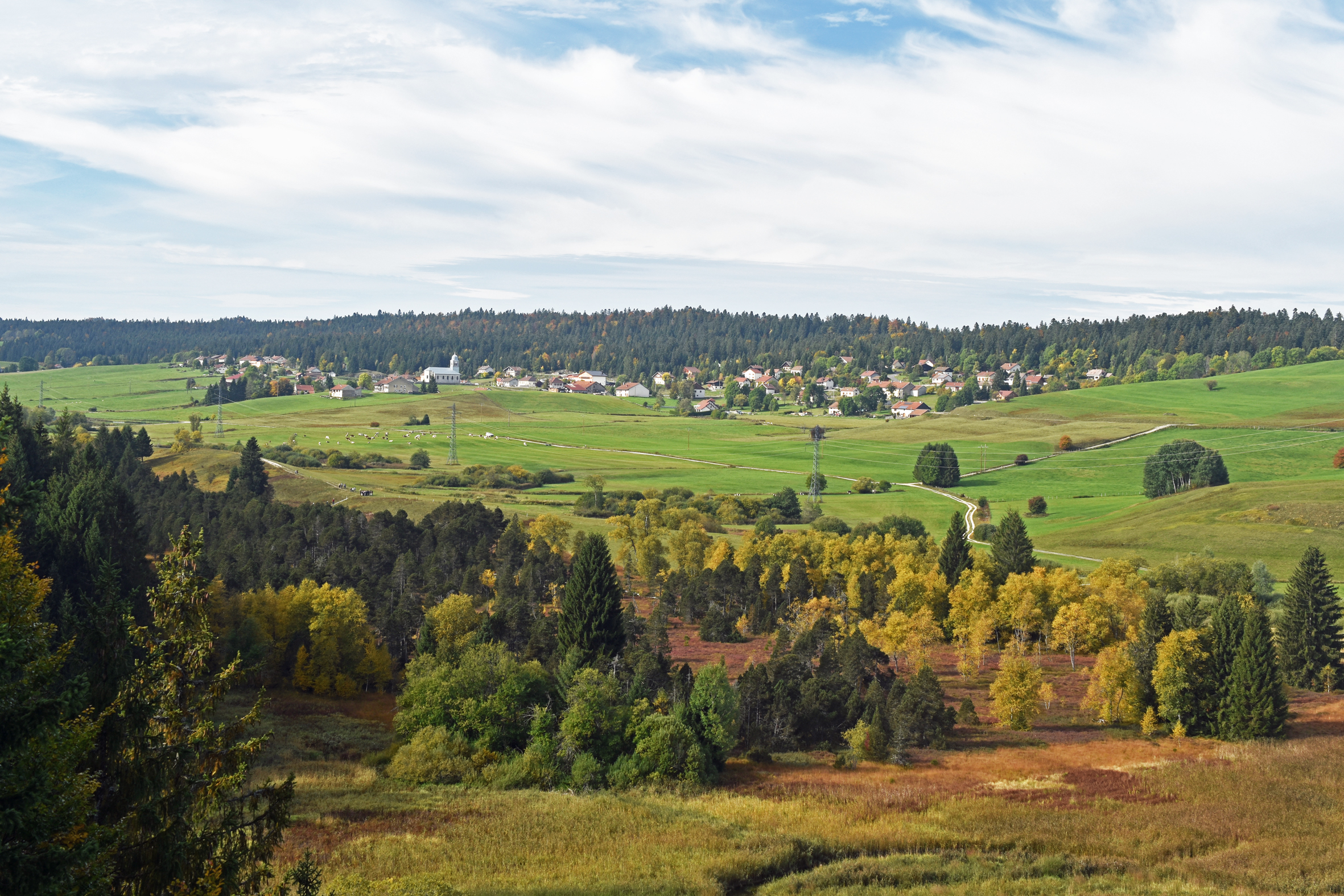
The belvederes and the peat bog of Nanchez - Prénovel
Throughout the seasons, this walk will lead you through the middle of freshly flowered prairies in the height of summer, through fields of snow in the winter with imprints of the wild fauna, and to the heart of the open spruce forests and the peat bog’s taiga landscape.
From the belvederes, open views open out over the combe and its winding rivers, whilst, to the east, the summits of the High-Jura outline the horizon.
11 points of interest
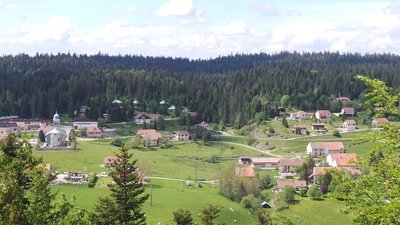
M.VOULOT ViewpointBelvedere of the Duchet
Perched 971 m high-up on the Bois de la Joux anticline, this belvedere overlooks the Anchey Combe (or the Prénovel-Les-Piards combe). According to geologists, this combe is a real combe, dug into the mountain by erosion. The mildness of the slopes is the result of the glaciers having deposited moraines. This combe is now used for hay fields.
The Nanchez forebay (or the Anchey forebay), which winds along the foot of the belvedere, has once more joined its meanderings since 2016, slowing flood flows and benefitting biodiversity and the rivers downstream.
From the north to the south, you will see various hamlets: Prénovel de Bise, les Belbenoîts, les Janiers (with the church), Les Fans and Les Berrods. To the south, you should be able to make out the village of Les Piards, where the houses are much closer together.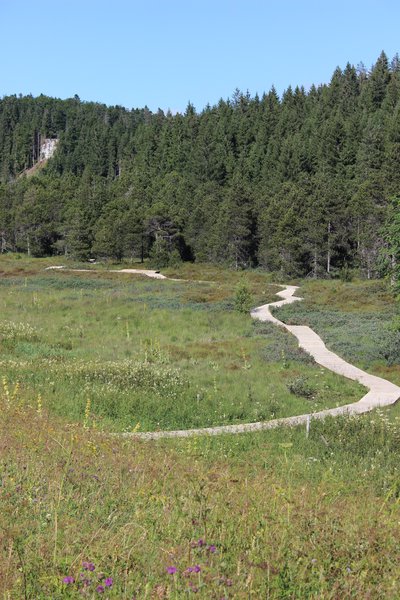
Tourbière de Nanchez - Julien Vandelle Natural environmentsThe Nanchez peat bog
Peat bogs are characterised by a surface that is constantly water-logged, where peat forms and accumulates: it is a type of bedding made-up of dead vegetation which has badly decomposed due to the absence of oxygen. Life conditions are demanding in these environments and this means that the species that live here must adapt to the omnipresence of water, to a relatively cold climate and to the chemical composition of the soil.
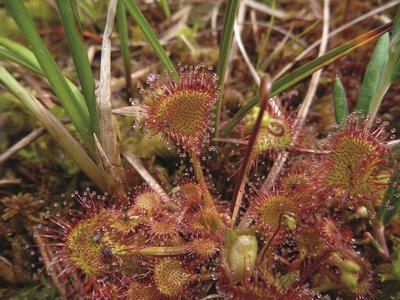
Droséra - PNRHJ / Pierre Durlet FloraSundew
This small carnivorous plant traps insects using its sticky digestive-juice covered hair. This adjustment allows the plant to acquire additional nutrients in this environment where its roots struggle to find enough food.

Airelle des marais - PNRHJ / Carole Zakin FloraThe bog bilberry
This phony blueberry favours environments that are slightly acidic, which is why it can be found in raised bogs or bogs that are in the process of drying out. Its edible berries, which mature mid-summer, are not as sweet as blueberries.
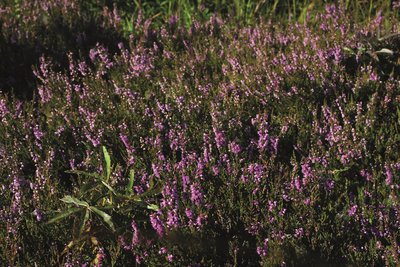
Callune - Julien Guyonneau FloraCalluna
This plant’s roots produce toxic secretions which hinder the growth of other species. It is often called common heather.
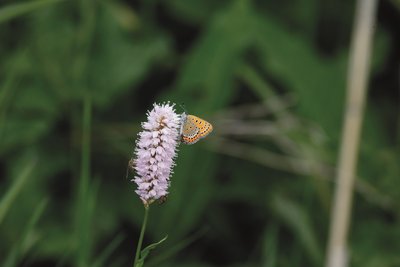
Cuivré de la bistorte - Pierre-Marie Aubertel FaunaThe violet copper
This butterfly is typical of northern regions. Adults can be seen flying around in May and at the beginning of June. Females lay their eggs by sliding backwards under the leaves of the common bistort. Caterpillars then complete their development on the underside of these leaves.
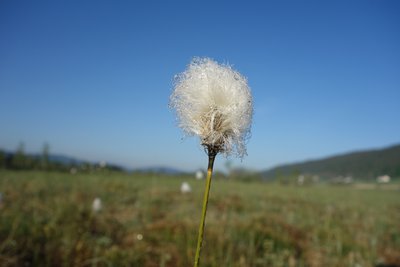
Linaigrette - PNRHJ / Carole Zakin FloraCottongrass
Their silky tuft does not appear during the flowering stage but rather the fruit stage: the cotton-like fibres that make-up this tuft are carried by the wind to aid the dispersal of its seeds.
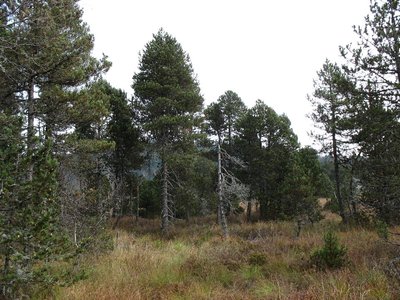
Pins - PNRHJ / Marie Voccia FloraMountain pine
In the Jura, these trees are found almost exclusively in peat bogs: its bushy silhouette, its short needles that grow in pairs of two and the hook on the leaves of its cones are some of its distinctive features that will help you to identify one.
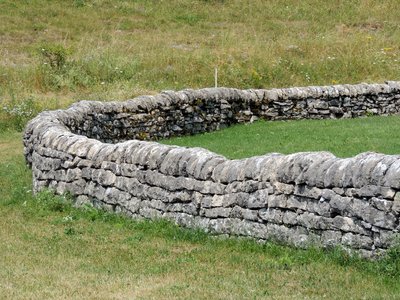
Faîtage des murets - PNRHJ - F. Jeanparis History & HeritageThe crown of the low walls
The capping on the low dry-stone walls, or crown, maintains and stabilises the sides (visible parts) of the wall. Without it, the stones, and particularly those at the top, would end up falling. Here, you can observe a technique in which large and relatively flat stones, called lauzes, are laid vertically and often stabilised by spacers in between.
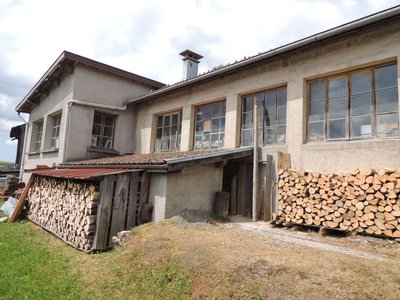
Atelier de tournerie - PNRHJ - F. Jeanparis History & HeritageWood-turning workshops
More than a place of work or a rudimentary shelter for craftsmen, for those who occupied it, the workshop is a setting that is both intimate and public.
Between the tools used, on the worktops where sawdust is pushed away with the palm of a hand, is where craftsmen build their know-how, by the light shed by the large dusty windows.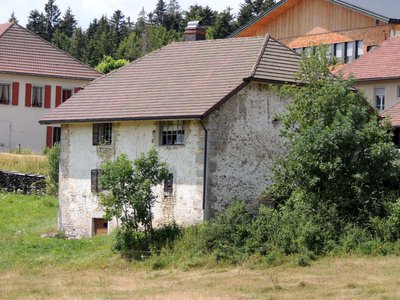
PNRHJ - F. Jeanparis History & HeritageThe evolution of life and buildings
The rural house was first the one belonging to the farmer and livestock breed, where men and animals lived together. As from the 18th century, cheese specialisation and the pooling of milk in cooperative structures - “fruitières” - brought farmers out of a self-subsistence economy. In terms of buildings, the farm became bigger: a storey is added to include bedrooms, a second stable is sometimes built to accommodate more animals.
Description
Departing from PRENOVEL, take the road (yellow waymarking) around the holiday resort towards Champs de la Vie. Cross the départementale road with care, and then head through the Champs de la Vie, to reach the Crest Bridge.
Follow the forest path to the left until you come to La Faicle. Climb up a steepish slope to the left until you reach the DUCHET BELVEDERE.
The trail heads back downhill to the right until it comes to the Duchet Forest. At the junction, the trail rapidly descends towards Sous Duchet.
Continue on the grassy path to the right, that overlooks and runs along the stream. Head past Le cotat Bossu and arrive at THE PEAT BOG. Down to your right, take the adapted trail to discover this particular natural environment.
At the Crossing of Forebays, continue on the path to your right, cross the stream and reach Le Pontet, at the départemental road. Cross the road with care, and follow it for 140 m before climbing a well-marked steep slope into the forest, punctuated by the BELVEDERE OVER THE FORT.
Make a U-turn, head to Le Pontet, and then head towards PRENOVEL DE BISE, through the hamlet of l’Arête.
Cross the départemental road again and take a white path through pastures until you enter the hamlet of Belbenoits. Head back downhill to your left until you come to the Walkway.
Continue on the white path running parallel to the Nanchez forebay, crossing over the Janiers Bridge.
At La Vigne, head back to your starting point via the municipal road.
- Departure : Nanchez, Annex town hall of Prénovel
- Arrival : Nanchez, Annex town hall of Prénovel
- Towns crossed : Nanchez and Grande-Riviere Chateau
Forecast
Sensitive areas
- Impacted practices:
- Aquatic,
- Sensitivity periods:
- JanFebMarAprMayJunJulAugSepOctNovDec
- Contact:
- Parc naturel régional du Haut-Jura
29 Le Village
39310 Lajoux
03 84 34 12 30
www.parc-haut-jura.fr/
- Impacted practices:
- Aerial, Aquatic, Amenities, , Underground, Land-based
- Sensitivity periods:
- JanFebMarAprMayJunJulAugSepOctNovDec
- Contact:
- Conservateur : Laurane Palanchonl.palanchon@parc-haut-jura.fr Parc Naturel Régional du Haut-Jura29 le village39310 LAJOUX03 84 34 12 30
Recommandations
This trail passes through pastures with livestock. To respect the owners and farmers granting you passage, to avoid flattening the hay, and for the security of livestock and wild fauna, we ask that you remain on the waymarked paths. Use the adapted passageways to get across fencing and be sure to close gateways behind you.
Please keep your dog on a lead if you have one.
In the peat bog and its surrounding fields, wild flowers are beautiful, they may be rare and protected and often wilt quickly. Do not pick them! They will delight the next hikers.
In case of forest works (felling, skidding, etc.), for your safety, know when to stop and turn around.
In the adapted area of the peat bog (boardwalk), between THE PEAT BOG and Le Pontet, for the safety of all and to respect this unique environment, there are a few additional rules:
- Do not leave the boardwalk
- Cycling is not authorised.
Information desks
Tourist information centre - Haut-Jura Grandvaux
7 place Simone Veil, 39150 Saint-Laurent-en-Grandvaux
Transport
To visit and get about in the High-Jura, visit www.reshaut-jura.fr, the eco-mobility portal listing all means of transport within the Park.
Access and parking
15 km from Saint-Laurent-en-Grandvaux, via the D 678, the D 146, followed by the D 28 and the D 232.
Parking :
Report a problem or an error
If you have found an error on this page or if you have noticed any problems during your hike, please report them to us here:
